143 books about Poverty & Homelessness and 11
start with F
143 books about Poverty & Homelessness and 11
143 books about Poverty & Homelessness
11 start with F start with F
11 start with F start with F

The Fair Trade Scandal
Marketing Poverty to Benefit the Rich
Ndongo Samba Sylla
Pluto Press, 2014
The Fair Trade Scandal takes aim at the Fair Trade consumer movement which many assume to be entirely benign. Through a razor-sharp analysis based on insider knowledge, Ndongo Sylla shows that there is a big gap between the rhetoric of Fair Trade and its practical results.
Sylla shows empirically that Fair Trade excludes those who need it the most and that its benefits are essentially captured by the wealthiest groups in the supply chain. Based on his experience of working for Fairtrade International, Sylla shows the flaws in the Fair Trade system which compromise its ethical mission.
The Fair Trade Scandal is both a provocative and deeply informative exploration of the Fair Trade phenomenon, suitable for specialists and non-specialists alike.
Sylla shows empirically that Fair Trade excludes those who need it the most and that its benefits are essentially captured by the wealthiest groups in the supply chain. Based on his experience of working for Fairtrade International, Sylla shows the flaws in the Fair Trade system which compromise its ethical mission.
The Fair Trade Scandal is both a provocative and deeply informative exploration of the Fair Trade phenomenon, suitable for specialists and non-specialists alike.
[more]
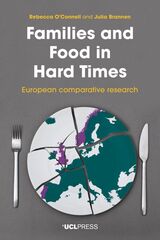
Families and Food in Hard Times
European Comparative Research
Rebecca O'Connell and Julia Brannen
University College London, 2021
An examination of food poverty in austerity-era Europe.
Food is fundamental, yet food poverty has increased in the Global North. Adopting a comparative case approach, Food and Families in Hard Times addresses the global problem of economic retrenchment and the burden it places on the most vulnerable. This timely book examines food poverty in the United Kingdom, Portugal, and Norway following the 2008 financial crisis, examining the resources available to families in relation to the intersection of public policies, local institutions, and kinship networks. The book explores the ways that low income impacts household food provisioning, formal and informal support for struggling families, the provision and role of school meals, and constraints upon families’ social participation. Drawing upon extensive and intensive knowledge on the conditions and experiences of low-income families, the book also draws upon current research in European social science literature to shed light on the causes and consequences of food poverty in austerity-era Europe.
Food is fundamental, yet food poverty has increased in the Global North. Adopting a comparative case approach, Food and Families in Hard Times addresses the global problem of economic retrenchment and the burden it places on the most vulnerable. This timely book examines food poverty in the United Kingdom, Portugal, and Norway following the 2008 financial crisis, examining the resources available to families in relation to the intersection of public policies, local institutions, and kinship networks. The book explores the ways that low income impacts household food provisioning, formal and informal support for struggling families, the provision and role of school meals, and constraints upon families’ social participation. Drawing upon extensive and intensive knowledge on the conditions and experiences of low-income families, the book also draws upon current research in European social science literature to shed light on the causes and consequences of food poverty in austerity-era Europe.
[more]
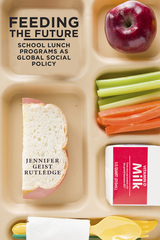
Feeding the Future
School Lunch Programs as Global Social Policy
Rutledge, Jennifer Geist
Rutgers University Press, 2016
A century ago, only local charities existed to feed children. Today 368 million children receive school lunches in 151 countries, in programs supported by state and national governments. In Feeding the Future, Jennifer Geist Rutledge investigates how and why states have assumed responsibility for feeding children, chronicling the origins and spread of school lunch programs around the world, starting with the adoption of these programs in the United States and some Western European nations, and then tracing their growth through the efforts of the World Food Program.
The primary focus of Feeding the Future is on social policy formation: how and why did school lunch programs emerge? Given that all countries developed education systems, why do some countries have these programs and others do not? Rutledge draws on a wealth of information—including archival resources, interviews with national policymakers in several countries, United Nations data, and agricultural statistics—to underscore the ways in which a combination of ideological and material factors led to the creation of these enduringly popular policies. She shows that, in many ways, these programs emerged largely as an unintended effect of agricultural policy that rewarded farmers for producing surpluses. School lunches provided a ready outlet for this surplus. She also describes how, in each of the cases of school lunch creation, policy entrepreneurs, motivated by a commitment to alleviate childhood malnutrition, harnessed different ideas that were relevant to their state or organization in order to funnel these agricultural surpluses into school lunch programs.
The public debate over how we feed our children is becoming more and more politically charged. Feeding the Future provides vital background to these debates, illuminating the history of food policies and the ways our food system is shaped by global social policy.
[more]
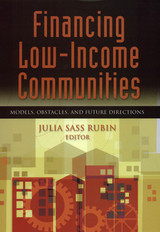
Financing Low Income Communities
Julia Sass Rubin
Russell Sage Foundation, 2007
Access to capital and financial services is crucial for healthy communities. However, many impoverished individuals and neighborhoods are routinely ignored by mainstream financial institutions. This neglect led to the creation of community development financial institutions (CDFIs), which provide low-income communities with financial services and act as a conduit to conventional financial organizations and capital markets. Edited by Julia Sass Rubin, Financing Low-Income Communities brings together leading experts in the field to assess what we know about the challenges of bringing financial services and capital to poor communities, map out future lines of research, and propose policy reforms to make these efforts more effective. The contributors to Financing Low-Income Communities distill research on key topics related to community development finance. Daniel Schneider and Peter Tufano examine the obstacles that make saving and asset accumulation difficult for low-income households—such as the fact that tens of millions of low-income and minority adults don't have a bank account—and consider solutions, like making it easier for low-wage workers to enroll in 401(K) plans. Jeanne Hogarth, Jane Kolodinksy, and Marianne Hilgert review evidence showing that community-based financial education programs can be effective in changing families' saving and budgeting patterns. Lisa Servon proposes strategies for addressing the challenges facing the microenterprise field in the United States. Julia Sass Rubin discusses ways community loan and venture capital funds have adapted in response to the decreased availability of funding, and considers potential sources of new capital, such as state governments and public pension funds. Marva Williams explores the evolution and recent performance of community development banks and credit unions. Kathleen Engel and Patricia McCoy document the proliferation of predatory lenders, who market loans at onerous interest rates to financially vulnerable families and the devastating effects of such lending on communities—from increased crime to falling home values and lower tax revenues. Rachel Bratt reviews the policies and programs used to make rental and owned housing financially accessible. Rob Hollister proposes a framework for evaluating the contributions of community development financial institutions. Despite the many accomplishments of CDFIs over the last four decades, changing political and economic conditions make it imperative that they adapt in order to survive. Financing Low-Income Communities charts out new directions for public and private organizations which aim to end the financial exclusion of marginalized neighborhoods.
[more]
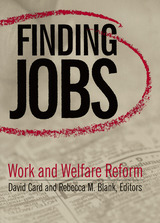
Finding Jobs
Work and Welfare Reform
David Card
Russell Sage Foundation, 2000
Do plummeting welfare caseloads and rising employment prove that welfare reform policies have succeeded, or is this success due primarily to the job explosion created by today's robust economy? With roughly one to two million people expected to leave welfare in the coming decades, uncertainty about their long-term prospects troubles many social scientists. Finding Jobs offers a thorough examination of the low-skill labor market and its capacity to sustain this rising tide of workers, many of whom are single mothers with limited education. Each chapter examines specific trends in the labor market to ask such questions as: How secure are these low-skill jobs, particularly in the event of a recession? What can these workers expect in terms of wage growth and career advancement opportunities? How will a surge in the workforce affect opportunities for those already employed in low-skill jobs? Finding Jobs offers both good and bad news about work and welfare reform. Although the research presented in this book demonstrates that it is possible to find jobs for people who have traditionally relied on public assistance, it also offers cautionary evidence that today's strong economy may mask enduring underlying problems. Finding Jobs shows that the low-wage labor market is particularly vulnerable to economic downswings and that lower skilled workers enjoy less job stability. Several chapters illustrate why financial incentives, such as the Earned Income Tax Credit (EITC), are as essential to encouraging workforce participation as job search programs. Other chapters show the importance of including provisions for health insurance, and of increasing subsidies for child care to assist the large population of working single mothers affected by welfare reform. Finding Jobs also examines the potential costs of new welfare restrictions. It looks at how states can improve their flexibility in imposing time limits on families receiving welfare, and calls into question the cutbacks in eligibility for immigrants, who traditionally have relied less on public assistance than their native-born counterparts. Finding Jobs is an informative and wide-ranging inquiry into the issues raised by welfare reform. Based on comprehensive new data, this volume offers valuable guidance to policymakers looking to design policies that will increase work, raise incomes, and lower poverty in changing economic conditions.
[more]
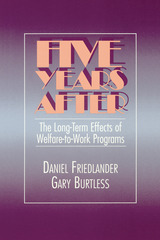
Five Years After
The Long-Term Effects of Welfare-to-Work Programs
Daniel Friedlander
Russell Sage Foundation, 1995
Friedlander and Burtless teach us why welfare reform will not be easy. Their sobering assessment of job training programs willenlighten a debate too often dominated by wishful thinking and political rhetoric. Look for their findings to be cited for many years to come. —Douglas Besharov, American Enterprise Institute A methodologically astute study that sheds considerable light on the potential for and limits to raising the employment and earnings of welfare recipients and provides benchmarks against which the impacts of later programs can be compared. —Journal of Economic Literature With welfare reforms tested in almost every state and plans for a comprehensive federal overall on the horizon, it is increasingly important for Americans to understand how policy changes are likely to affect the lives of welfare recipients. Five Years After tells the story of what happened to the welfare recipients who participated in the influential welfare-to-work experiments conducted by several states in the mid-1980s.The authors review the distinctive goals and procedures of evaluations performed in Arkansas, Baltimore, San Diego, and Virginia, and then examine five years of follow-up data to determine whether the initial positive impact on employment, earnings, and welfare costs held up over time. The results were surprisingly consistent. Low-cost programs that saved money by getting individuals into jobs quickly did little to reduce poverty in the long run. Only higher-cost educational programs enabled welfare recipients to hold down jobs successfully and stay off welfare. Five Years After ends speculation about the viability of the first generation of employment programs for welfare recipients, delineates the hard choices that must be made among competing approaches, and provides a well-documented foundation for building more comprehensive programs for the next generation. A sobering tale for welfare reformers of all political persuasions, this book poses a serious challenge to anyone who promises to end welfare dependency by cutting welfare budgets.
[more]

For a Liberatory Politics of Home
Michele Lancione
Duke University Press, 2023
In For a Liberatory Politics of Home, Michele Lancione questions accepted understandings of home and homelessness to offer a radical proposition: homelessness cannot be solved without dismantling current understandings of home. Conventionally, home is framed as a place of security and belonging, while its loss defines what it means to be homeless. On the basis of this binary, a whole industry of policy interventions, knowledge production, and organizing fails to provide solutions to homelessness but perpetuates violent and precarious forms of inhabitation. Drawing on his research and activism around housing in Europe, Lancione attends to the interlocking crises of home and homelessness by recentering the political charge of precarious dwelling. It is there, if often in unannounced ways, that a profound struggle for a differential kind of homing signals multiple possibilities to transcend the violences of home/homelessness. In advancing a new approach to work with the politics of inhabitation, Lancione provides a critique of current practices and offers a transformative vision for a renewed, liberatory politics of home.
[more]
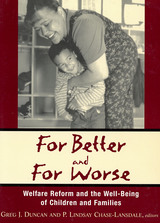
For Better and For Worse
Welfare Reform and the Well-Being of Children and Families
Greg J. Duncan
Russell Sage Foundation, 2001
The 1996 welfare reform bill marked the beginning of a new era in public assistance. Although the new law has reduced welfare rolls, falling caseloads do not necessarily mean a better standard of living for families. In For Better and For Worse, editors Greg J. Duncan and P. Lindsay Chase-Lansdale and a roster of distinguished experts examine the evidence and evaluate whether welfare reform has met one of its chief goals-improving the well-being of the nation's poor children. For Better and For Worse opens with a lively political history of the welfare reform legislation, which demonstrates how conservative politicians capitalize on public concern over such social problems as single parenthood to win support for the radical reforms. Part I reviews how individual states redesigned, implemented, and are managing their welfare systems. These chapters show that most states appear to view maternal employment, rather that income enhancement and marriage, as key to improving child well-being. Part II focuses on national and multistate evaluations of the changes in welfare to examine how families and children are actually faring under the new system. These chapters suggest that work-focused reforms have not hurt children, and that reforms that provide financial support for working families can actually enhance children's development. Part III presents a variety of perspectives on policy options for the future. Remarkable here is the common ground for both liberals and conservatives on the need to support work and at the same time strengthen safety-net programs such as Food Stamps. Although welfare reform-along with the Earned Income Tax Credit and the booming economy of the nineties-has helped bring mothers into the labor force and some children out of poverty, the nation still faces daunting challenges in helping single parents become permanent members of the workforce. For Better and For Worse gathers the most recent data on the effects of welfare reform in one timely volume focused on improving the life chances of poor children.
[more]
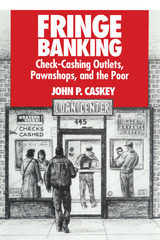
Fringe Banking
Check-Cashing Outlets, Pawnshops, and the Poor
John P. Caskey
Russell Sage Foundation, 1994
"Cogently argued, fills an important gap in the literature, and is accessible to undergraduates." —Choice "Dismantles the mythology surrounding pawnshops and check-cashing outlets, and demonstrates that they are no longer on the fringe of our financial system but integral to it."—San Francisco Bay Guardian In today's world of electronic cash transfers, automated teller machines, and credit cards, the image of the musty, junk-laden pawnshop seems a relic of the past. But it is not. The 1980s witnessed a tremendous boom in pawnbroking. There are now more pawnshops thanever before in U.S. history, and they are found not only in large cities but in towns and suburbs throughout the nation. As John Caskey demonstrates in Fringe Banking, the increased public patronage of both pawnshops and commercial check-cashing outlets signals the growing number of American households now living on a cash-only basis, with no connection to any mainstream credit facilities or banking services. Fringe Banking is the first comprehensive study of pawnshops and check-cashing outlets, profiling their operations, customers, and recent growth from family-owned shops to such successful outlet chains as Cash American and ACE America's Cash Express. It explains why, despite interest rates and fees substantially higher than those of banks, their use has so dramatically increased. According to Caskey, declining family earnings, changing family structures, a growing immigrant population, and lack of household budgeting skills has greatly reduced the demand for bank deposit services among millions of Americans. In addition, banks responded to 1980s regulatory changes by increasing fees on deposit accounts with small balances and closing branches in many poor urban areas. These factors combined to leave many low- and moderate-income families without access to checking privileges, credit services, and bank loans. Pawnshops and check-cashing outlets provide such families with essential financial services thay cannot obtain elsewhere. Caskey notes that fringe banks, particularly check-cashing outlets, are also utilized by families who could participate in the formal banking system, but are willing to pay more for convenience and quick access to cash. Caskey argues that, contrary to their historical reputation as predators milking the poor and desperate, pawnshops and check-cashing outlets play a key financial role for disadvantaged groups. Citing the inconsistent and often unenforced state laws currently governing the industry, Fringe Banking challenges policy makers to design regulations that will allow fringe banks to remain profitable without exploiting the customers who depend on them.
[more]
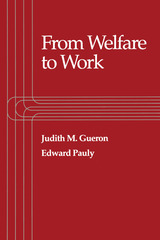
From Welfare to Work
Judith M. Gueron
Russell Sage Foundation, 1991
From Welfare to Work appears at a critical moment, when all fifty states are wrestling with tough budgetary and program choices as they implement the new federal welfare reforms. This book is a definitive analysis of the landmark social research that has directly informed those choices: the rigorous evaluation of programs designed to help welfare recipients become employed and self-sufficient. It discusses forty-five past and current studies, focusing on the series of seminal evaluations conducted by the Manpower Demonstration Research Corporation over the last fifteen years. Which of these welfare-to-work programs have worked? For whom and at what cost? In answering these key questions, the authors clearly delineate the trade-offs facing policymakers as they strive to achieve the multiple goals of alleviating poverty, helping the most disadvantaged, curtailing dependence, and effecting welfare savings. The authors present compelling evidence that the generally low-cost, primarily job search-oriented programs of the late 1980s achieved sustained earnings gains and welfare savings. However, getting people out of poverty and helping those who are most disadvantaged may require some intensive, higher-cost services such as education and training. The authors explore a range of studies now in progress that will address these and other urgent issues. They also point to encouraging results from programs that were operating in San Diego and Baltimore, which suggest the potential value of a mixed strategy: combining job search and other low-cost activities for a broad portion of the caseload with more specialized services for smaller groups. Offering both an authoritative synthesis of work already done and recommendations for future innovation, From Welfare to Work will be the standard resource and required reading for practitioners and students in the social policy, social welfare, and academic communities.
[more]
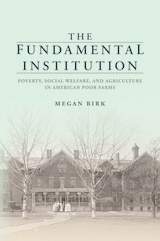
The Fundamental Institution
Poverty, Social Welfare, and Agriculture in American Poor Farms
Megan Birk
University of Illinois Press, 2022
By the early 1900s, the poor farm had become a ubiquitous part of America's social welfare system. Megan Birk's history of this foundational but forgotten institution focuses on the connection between agriculture, provisions for the disadvantaged, and the daily realities of life at poor farms. Conceived as an inexpensive way to provide care for the indigent, poor farms in fact attracted wards that ranged from abused wives and the elderly to orphans, the disabled, and disaster victims. Most people arrived unable rather than unwilling to work, some because of physical problems, others due to a lack of skills or because a changing labor market had left them behind. Birk blends the personal stories of participants with institutional histories to reveal a loose-knit system that provided a measure of care to everyone without an overarching philosophy of reform or rehabilitation.
In-depth and innovative, The Fundamental Institution offers an overdue portrait of rural social welfare in the United States.
[more]
READERS
Browse our collection.
PUBLISHERS
See BiblioVault's publisher services.
STUDENT SERVICES
Files for college accessibility offices.
UChicago Accessibility Resources
home | accessibility | search | about | contact us
BiblioVault ® 2001 - 2024
The University of Chicago Press









